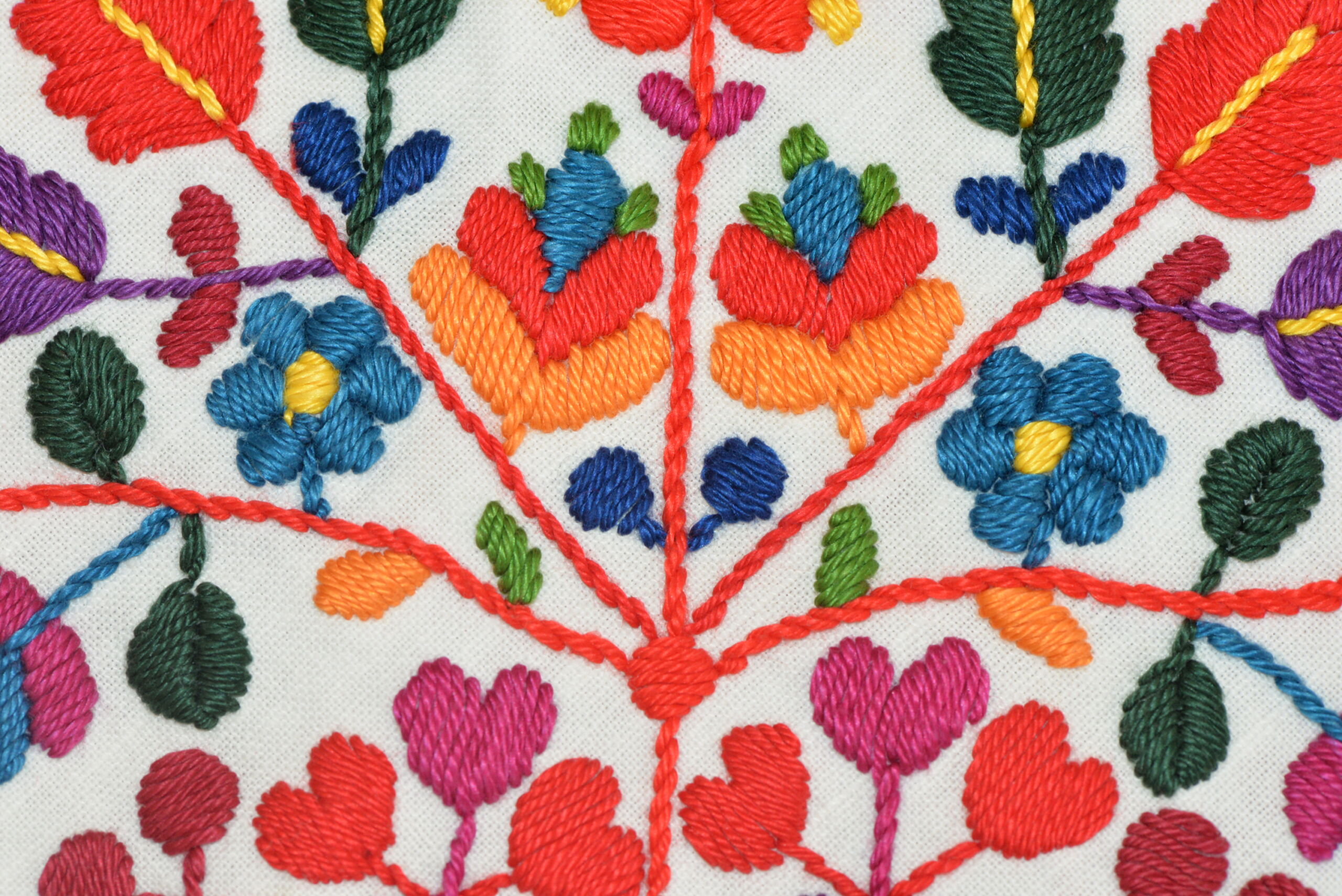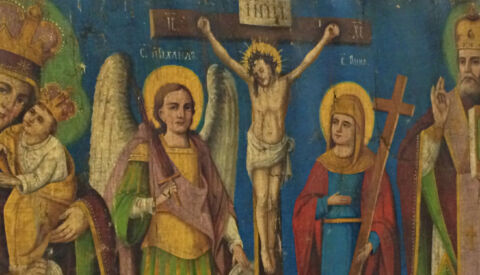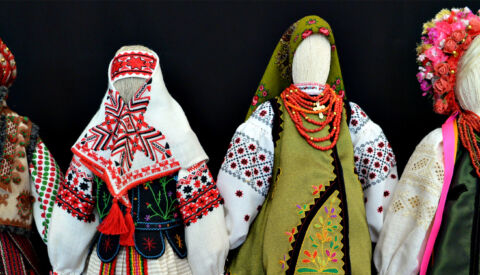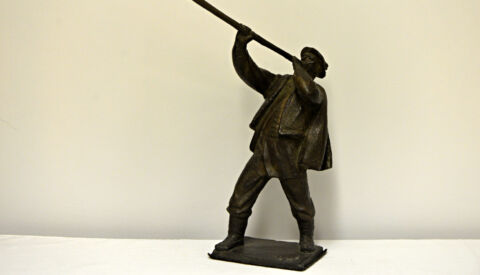Collection focuses on items that were woven or embroidered such as
clothing, rushnyky, tapestries, weavings and kylyms.
-
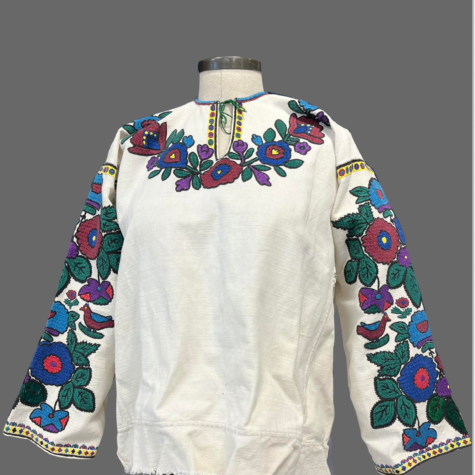
Bukovynian Blouse
Bukovyna is a historical region in the southwest of Ukraine. The region is known for its spectacular river, mountains, and vibrant celebration of Malanka. Bukovyna’s traditional embroidered shirt has a lot of floral patterns in satin stitch. Accordingly, the sleeves of this shirt are filled with a version of this floral satin stitch and the sleeves add two burgundy and amazing blue birds gazing at each other. Wool and cotton threads were used for the embroidery. The shirt was created in the 1950s.
-
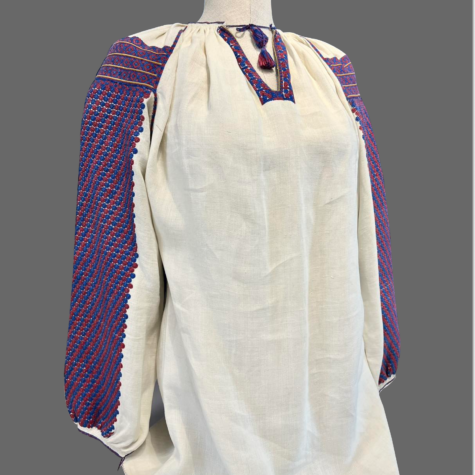
Kosiv Chemise
This linen chemise was created in the spectacular Hutsul cultural region, Verbovets village, Kosiv district in the early 20th century. The collar of this linen dodilna sorochka is embroidered with irregular cross stitch and stem stitch in royal blue and burgundy. Such sorochky with fully embroidered sleeves were called “rukavivka”. It takes at least six months to make one. This rukavivka has around 18,358 spirals, which is 238,654 stitches.
-
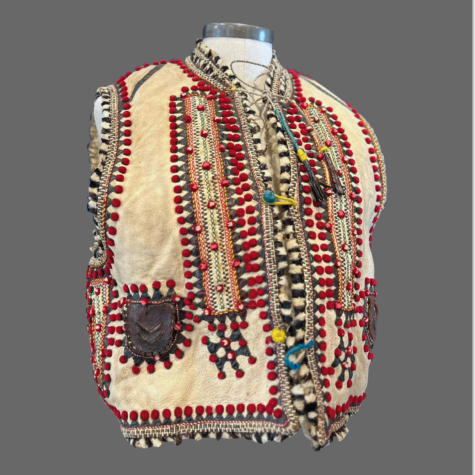
Pokuttia Keptar
This magnificent vest called “keptar” was obtained by the museum in 1984. Made with sheepskin leather it’s very warm and features a geometric embroidery motif. This Keptar was made c.1875 in Staryi Hvizdets village , Ivano-Frankivska oblast.
-
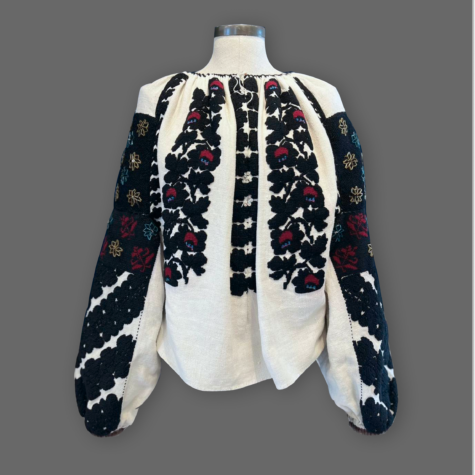
Zalishchyky Blouse
This blouse was made in 1905 in Zalishchyky district (1854-2020), Borshchiv cultural sub-region within the Western Podillian cultural region, which is now in Ternopil oblast (province) of western Ukraine, but which in 1905 was in the historical province of Halychyna. As was the tradition in late 19th and early 20th century Zalishchytski sorochky, it is lush and striking, embroidered with thick black woolen thread – and the pattern itself is thick and tight. The sleeves are gathered at the bottom with a narrow brown velvet band. The neckline is finished with black overcast stitch. The front and back each have 3 rows of black floral embroidery using half-cross stitch with a bit of wine, purple and blue, and a few silver sequins. The bottom is hand-hemmed.
-
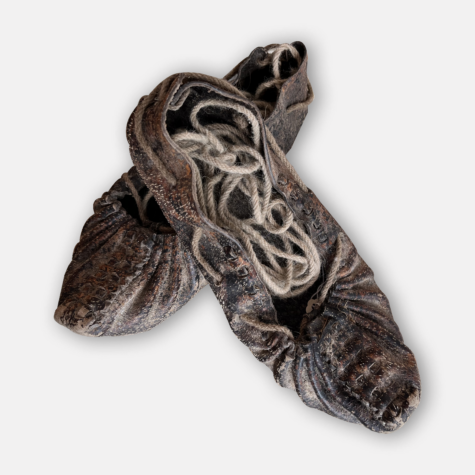
Postoly
Made in black with beige woolen cord for ties, these traditional Hutsul man’s leather shoes dates to the 19th century and are called Postoly. This pair in excellent condition was acquired by the museum in 1983. They were made of a single piece of leather (cow or soft pig) by stretching it together. For most of Ukraine, postoly were summer shoes, and only in some areas, they were worn all year round.
-
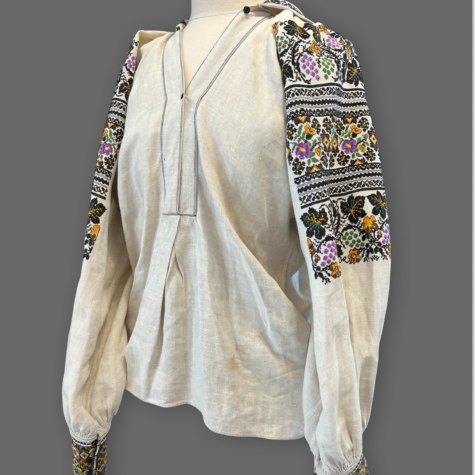
Sokal Blouse
This linen blouse was made between 1925 and 1930 in Sokalskyi povit, Voislavychi village, Halychyna province, now Livivska oblast (province) of western Ukraine. It was made with a popular-for-the-region sailor’s collar. Collars were an indication of status and family – the larger the collar, the wealthier the family. This excellent Sokal shirt has combined different types of stitches such as black backstitch and double running stitch, cross-stitch. The cuffs are finished with black-toothed edges in loops.
-
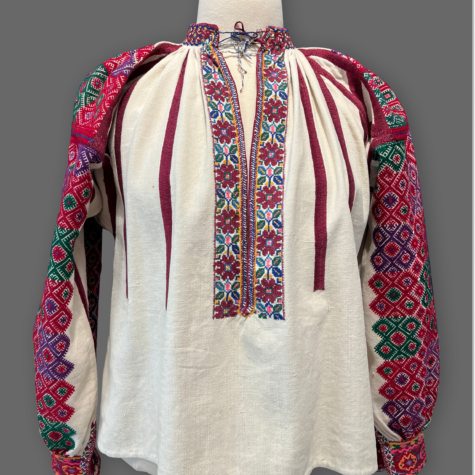
Pokuttia Blouse
This fancy embroidered blouse was created in Staryi Hvizdets village, Horodenka cultural sub-region, Pokuttia cultural region, and acquired by the museum in February 1985. It was made combining geometric and floral motifs on hempen fabric. The collar has a fertility motif. You can see multiple types of stitches, such as cross-stitch, half cross stitch, satin stitch, nyz, buttonhole stitch, blanket stitch, stem stitch and braid stitch.
-
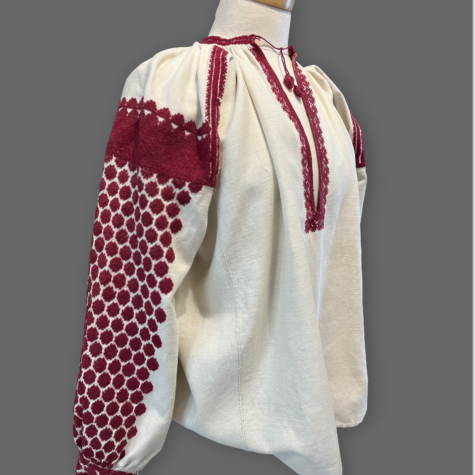
Pokuttia Blouse
This beautiful woman’s blouse was made in the village Staryi Hvizdets, in the cultural region of Pokuttia, (cultural sub-region Horodenka) and acquired by the museum in 1985. Аs a traditional Pokuttian sorochka it is embroidered in a stitching technique called “Verkhoplut”. Rhombus patterns reflect the symbol of the fertility of man and the earth. It is composed of two triangles, symbolizing the masculine and feminine.
-
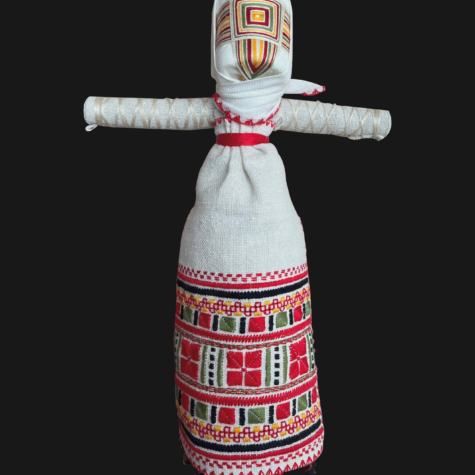
Motanka made by Tetiana and Natalka Katrychenko, Kyiv, Ukraine.
Motanka dolls differ from ordinary dolls by having a “blank” face. It was believed that it was through the face that a person’s soul could be tied to the doll or someone could be evil-eyed. On some motanka dolls, instead of a face, there was a cross, a symbol of the Sun, laid out with colored threads. The horizontal lines stood for the feminine and the vertical lines for the masculine.
-
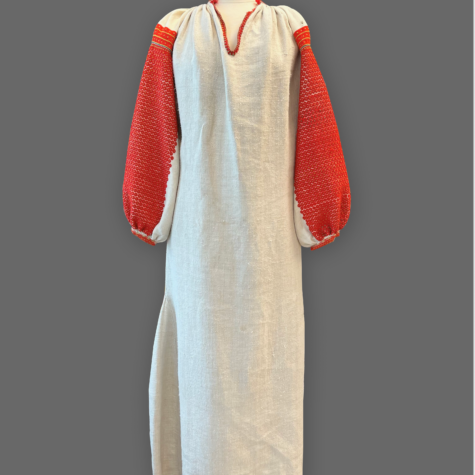
Embroidered chemise from the Hutsul region, Verbovets village
With embroidered sleeves in Twisted Backstitch, this type of chemise is called rukavivka because of its fully embroidered sleeves. The rukavivka was worn mainly by unmarried ladies and young women. Older women would not dress like this – it was too festive. Wearing a rukavivka meant that a girl was ready to get married. It was worn on major holidays and before marriage. Also, this shirt was worn on the last journey. After all, It took 2-3 winters to make the Verbovets’ rukavivka.
-
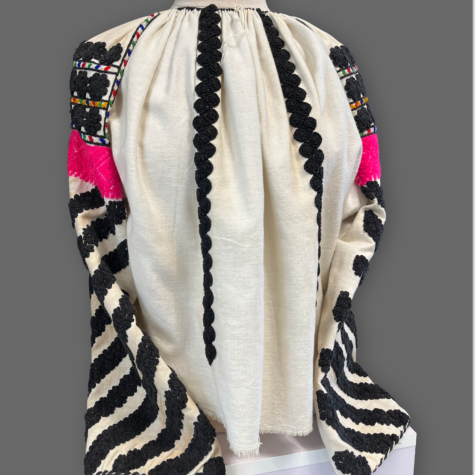
Bukovyna Shirt
This vibrant embroidered and beaded shirt was acquired by the museum in 1978, originally from Kadubivtsi village, historical province of Bukovyna. Shirts from Zastavna raion are distinguished from others by the upper band of the sleeves (“morshchynka”), which is always embroidered with woolen threads using only one color, as here it’s a band of pink wool in curly stitch. “Morshchynka” pattern was formed from 3-4 graphemes of large rhombuses due to the unstitched background of the canvas.
-
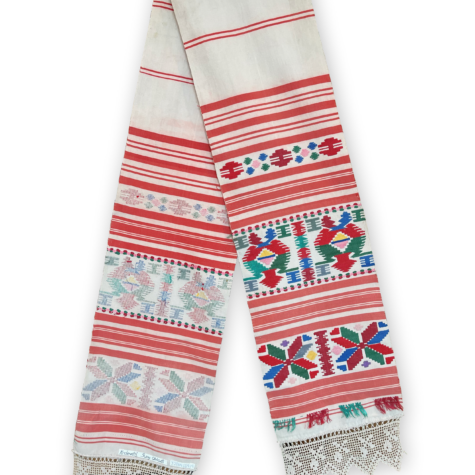
Symbolical features of Krolevets Rushnyk, Sumy regon
On the bottom of the towel is an octagonal flower. Flowers with eight petals show the passage of time, the cycle of nature and life with its continuation. Eagles. To this day, the issue of the depiction of two-headed eagles on woven fabrics remains controversial. Local ethnographer A. Karas claims that this is due to the territorial affiliation of the Krolevets district with the Chernihiv province, which had eagles on its coat of arms. Another version suggests that the artist used this image to confirm her literacy and understanding of tsarist money, which was also circulating in Krolevets. On coins, as well as on towels, the emblematic eagle had a specific pattern, which numismatists called “an eagle with outstretched wings” (in some places, eagles were also found with their wings down as a sign of humility). The rhombus. The basis for deciphering the meaning of the symbol is the masculine and feminine. In the pre-Ukrainian understanding, three corners of the rhombus are held by a woman (like the three corners of a home), and the fourth is held by a man, who completes the whole. The outer surface of the rhombus is decorated with denticles symbolizing rain or sunlight A ladder of rectangles. A symbol of a person’s ascent to the top of spirituality, to God, to heaven, to a better life. It is a typical element in complex ornaments. It is often used to frame a towel (in a border). The “ladder” symbol is closely related to the “tree of life”.
-
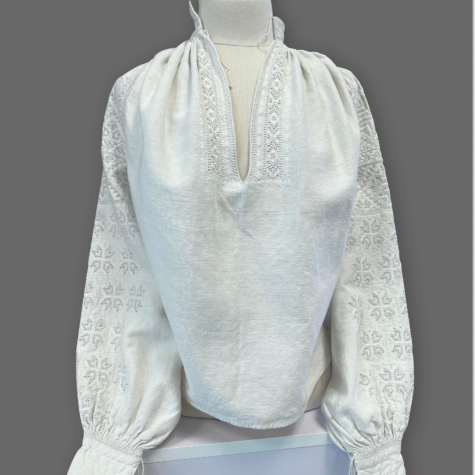
Pokuttia Blouse
This blouse was made in the late 19th century in Budyliv village, Sniatyn district (1854-2020), which was in the historical province of Halychyna, and is now in Ivano-Frankivsk oblast (province) in western Ukraine. The blouse belongs to the Sniatyn cultural sub-region of the Pokuttia cultural region. Using eyelets and white satin stitch, the blouse was embroidered on both sides of the front opening, on the shoulders and on top of the sleeves; the sleeves were joined to the body with two rows of hemstitch. The museum proudly acquired this linen blouse in 1988 thanks to the donation of Luba Kuc.
-
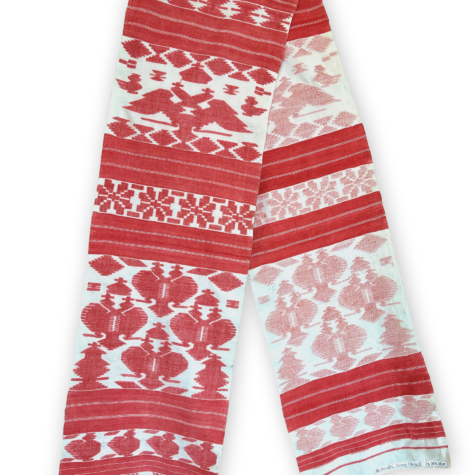
Symbolical features of Krolevets Rushnyk
Eagles. To this day, the issue of the depiction of two-headed eagles on woven fabrics remains controversial. Local ethnographer A. Karas claims that this is due to the territorial affiliation of the Krolevets district with the Chernihiv province, which had eagles on its coat of arms. Another version suggests that the artist used this image to confirm her literacy and understanding of tsarist money. A triangle with the top facing down. The symbol associated with the Moon, a female base, symbolizes the Goddess of the Giving Birth. A rhombus. The basis for deciphering the symbol’s meaning is the masculine and feminine. An octagonal flower. Flowers with eight petals show the passage of time, the cycle of nature and life with its continuation. Ducks. By depicting birds, ducks, they wanted to protect people from adversity.
-
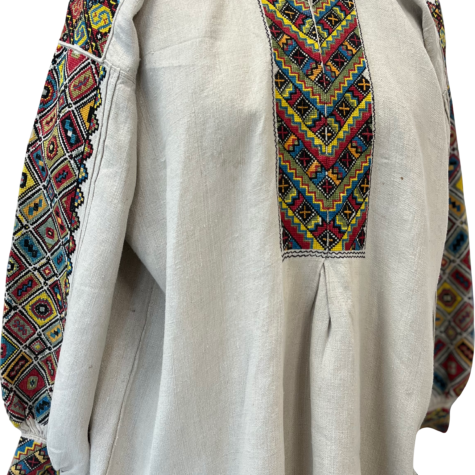
Halychyna Blouse
This embroidered blouse in a geometric pattern from historical Halychyna province was made in 1900 by Kateryna Tkhir and acquired by the museum in 1978. The origin of this blouse is Yastrubychi village, Sokal cultural region, which is currently in Lvivska oblast (province). The blouse has a unique mandarin collar with 3-button closure and has floral embroidery on it. Geometrical patterns of embroidery are the same on the front and cuffs, the sleeves are also embroidered in S-figures, rhombus, zigzags, crosses and other geometrical motifs. Interestingly, It was believed that wearing clothing embroidered with S-shaped symbols would shield human energy from harmful influences.
-

Symbolical features of Poltava Ritual Rushnyk
The Tree of Life with Flowers – the flowers symbolized the living, the buds symbolized future generations, and the fruits of the tree symbolized the deeds of people. The tree always had a large flower in the center at the top. It embodies the Fire of Life, which was guarded by two birds. The viburnum is a tree of the Ukrainian family that symbolizes loyalty, rebirth, hope, and is also a symbol of female beauty, strength, and health. In Ukraine, a viburnum branch was secretly given by a girl to her future groom as a sign of consent to marry. In the middle of the trunk are birds symbolizing brides and grooms. On a wedding towel the birds should be placed with their heads facing each other. On the edges of the wedding towel are ears of grain, so that life is full of bread and spikes. A circle with a dot inside is the center of the universe, and a symbol of the sun.
-
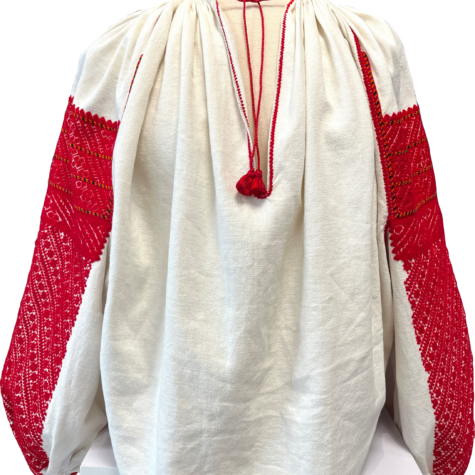
Sniatyn Blouse
The mid 1900s blouse is a great example of traditional Sniatyn festive shirts. Sniatyn is a cultural sub-region of Pokuttia in western Ukraine. This type of chemise is called rukavianka-chervonianka, which means ‘red sleeves’. The embroidery on such shirts was mostly done in red wool, with a somewhat thick thread which results in the patterns standing out from the background. The sleeves have a band of red flat stitch and extending from the band to the cuffs is a geometric motif in red cross stitch and satin stitch.
-
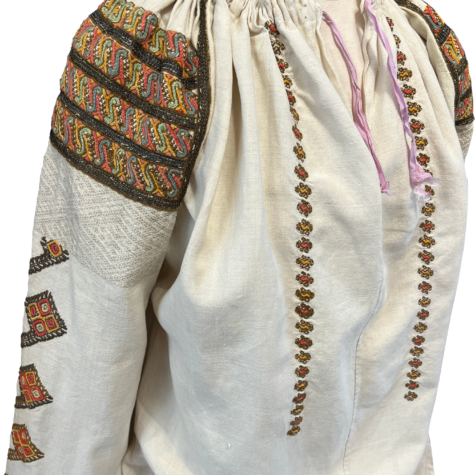
Pokuttia Shirt
Festive linen shirt made in 1869 in the region of Pokuttia, Zavallya village. Sleeves embroidered at shoulder in 4 rows of geometrical designs using brown stem stitch and cross stitch and blue, rose, yellow and light green chain stitch. They are separated by rows of chain stitch with metallic thread. Traditionally for Pokuttia blouses it has triangle, rhombus and S-shaped patterns in the geometric motifs.
-
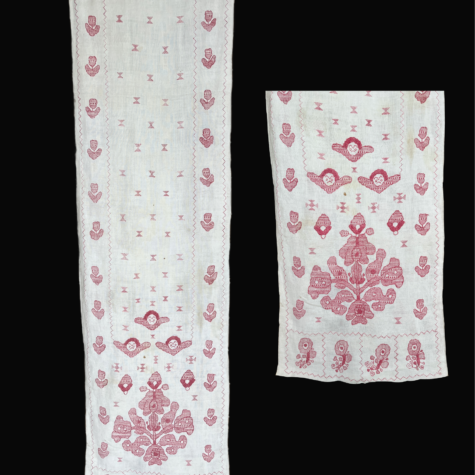
Symbolical features of Ceremonial Kharkiv Towel, late 18th century
– The zigzags symbolically depict water. – The triangles touching each other with their peaks, resembling an hourglass, symbolize the World and the Anti-World. And the place where they touch is a kind of transition from one world to another. – Tulips symbolize young boys. – The Tree of the Universe reflects the world of gods and universal laws. That is why the tree begins with a large flower, which denotes the otherworldly sun – the world of Nava. Two flowers that look up represent the world of Java. The tree ends with a flower that represents the Sun, the Creator, the world of Pravda. – Mallow, peony – faith, hope – Angels in the embroidery are meant to protect Rushnyk’s holder.
-
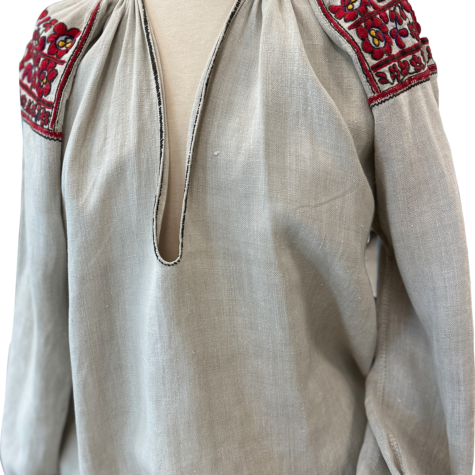
Kalush Shirt
Floral hempen linen shirt made in 1898 from the region of Pidhiria, Kalush city. This outstanding festive embroidered shirt was added to the museum’s collection in 1974. The sleeves have gussets and are joined to the shoulders with running stitch in black and red. Traditionally, for the region of Pidhiria, the blouse has embroidery on ustavka in red and outlined in black and blue. An interesting detail appears on the collar, where the embroidery in cross stitch presumably was unfinished.
-
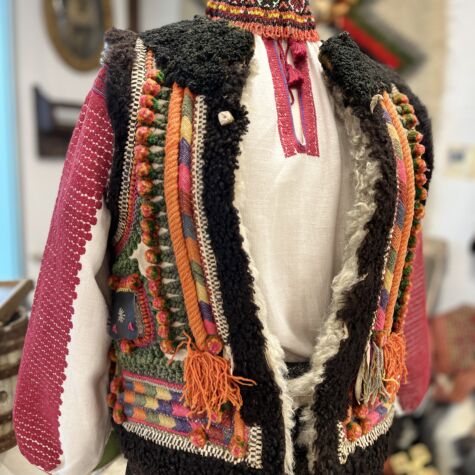
Hutsul Chemise
The embroidered blouse under the hutsul keptar was made in Kosiv district in the Hutsul region in the early 20th century. This blouse was embroidered in Staryi Kosiv in a traditional style for this area. The sleeves have rows of red flowers made of cross stitch and curly stitch. It is a long standing tradition that the embroidered shirts of the Kosiv area were distinguished by their completely covered sleeves in polychromatic embroidery. Such blouses are called “rukav”(sleeve) or “pysanee”(painted).
-
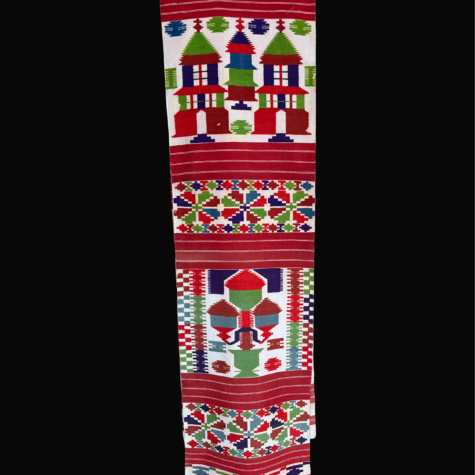
Krolevets Towel, late 19t century
An octagonal flower. Further ornamental bands of flowers are “VIRIAK” (Windflower). Flowers with eight petals show the passage of time, the cycle of nature and life with its continuation. The tree of life. An important attribute of Krolevets ornamentation is the Tree of Life, which symbolized the eternal mythological and spiritual connection of the past with the present, of natural phenomena with everyday human life, which harmoniously transformed into the image of a woman-mother – the Goddess Berehynia. The roof of the church. The towels that were donated to the church depicted the silhouettes of churches and bell towers, the so-called “monasteries”. The rhombus. The basis for deciphering the meaning of the symbol is the masculine and feminine. In the pre-Ukrainian understanding, three corners of the rhombus are held by a woman (like the three corners of a home), and the fourth is held by a man, who completes the whole. The outer surface of the rhombus is decorated with denticles symbolizing rain or sunlight
-
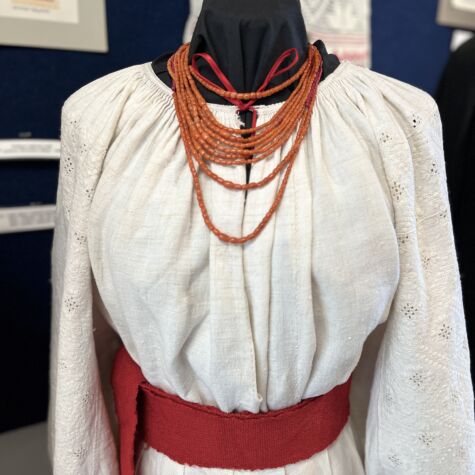
Poltava Chemise
This delicate late 19th-century sorochka was created in the village of Zhovnyn, once the Poltava region, and donated to the museum in 1996. As is traditional for a Poltava shirt, it has white on white flat stitch embroidery combined with a cutwork technique. The main features of Poltava embroidery that are also used in this sorochka are the richly expanded sleeves gathered at the insert, no cuffs and no collar. The Poltava shirts usually had no embroidery on the chest, anticipating the wearing of a lot of necklaces by the owner. The main geometric motifs are a cross, a rhombus, a triangle, a dot, and petals. Altogether, openwork techniques create a unique light and shadow effect!
-
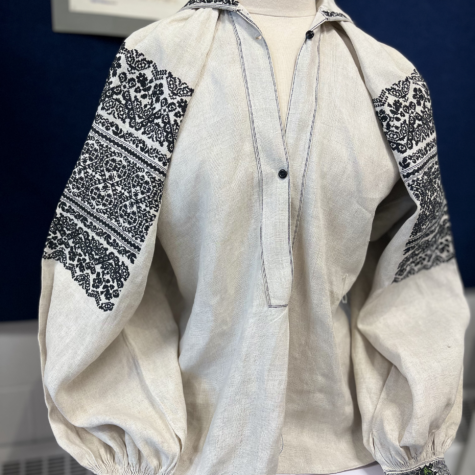
Sokal Chemise
This shirt is a great example of early 20th century Sokal region embroidery. Traditional for this region, the shirt is embroidered in black and has a sailor’s collar. Collars were an indication of status and family – the larger the coat, the wealthier the family. Legends say that the first Sokal shirt was black because the Mongol-Tatars burned the region, and a black road passed through Sokal, which was used to take girls from Ukraine into slavery. The shirt was donated to the museum in 2018 by Natalka Dobrolige and Ed Thompson. His grandmother, Oleksandra Kympinska-Taciun, embroidered this shirt. She was born and raised in the Belz area of the Sokal district of Halychyna province. She lived in Nismychi, Sokal district before coming to Canada circa 1933 in Fort William – Port Arthur.
-
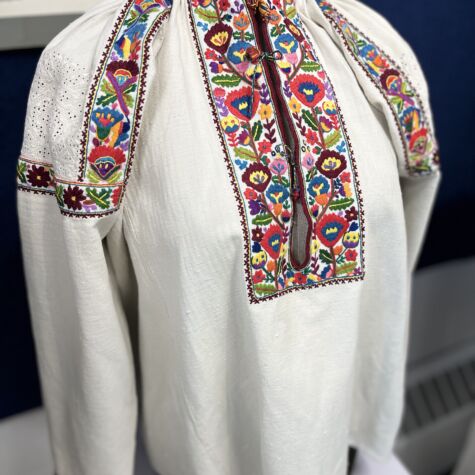
Pokuttia Blouse
This embroidered blouse in a floral pattern was acquired by the museum in 1985 from the Horodenka district of Ivano-Frankivska oblast. This blouse is from the village Staryi Hvizdets, historically the region of Pokuttia. As a traditional Pokuttian shirt it is linen, has floral patterns and gathered into the embroidered collar and cuffs. The cuffs of this blouse have a floral motif in the same colors as the rest of the blouse’s embroidery but done in cross stitch. The depicted floral motifs reflect the symbol of The Tree of Life, which means the unity of three worlds, but also the family and roots. It also features embroidery on the shoulders, which was combined with “dovbane” technique.
-
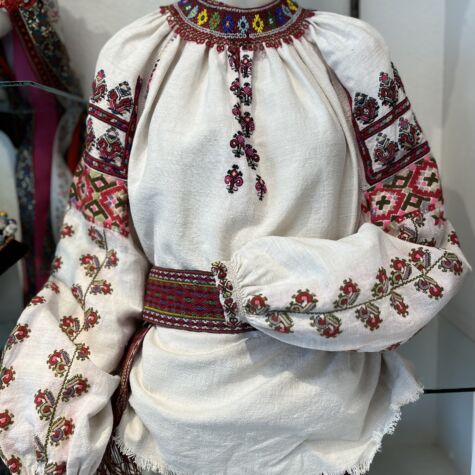
Bukovynian Chemise
Late 19th century Bukovynian Vyshyvanka that was added to our collection in 1996. As a traditional Ukrainian Bukovinian blouse it has a geometric floral motif motif in various colors, including black, dark pink, and green. Front opening, sides, bands on shoulders, and cuffs have a broad variety of stitch types, such as button hole stitch, arrow head stitch, chain stitch, braid stitch, cross stitch, half cross stitch, stem stitch, back stitch, and satin stitch. The embroidery of rhombs reflects the symbolism of the union of the sun and earth, of male and female. The star with eight rays also was known as the symbol of female and male principles, whereas the curved lines are a reflection of eternity. The bottom of the blouse is unfinished.
-
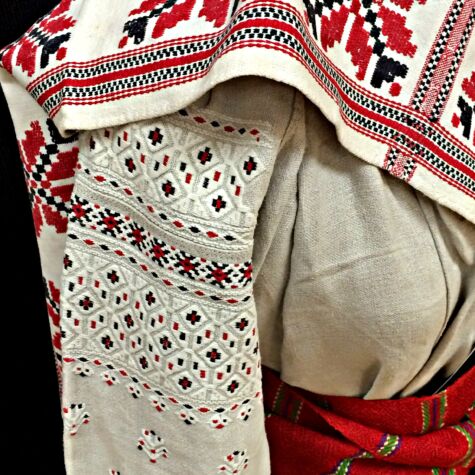
Semenivka Chemise
Part of a woman’s chemise (“dodilna sorochka”) featuring white, red and black satin stitch, a kerchief (“khustka”) with woven red and black geometric design, and a woven red, green, purple and white belt (“kraika”) all from Semenivka district in northern Chernihiv province. Semenivka district is the only part of the region formerly known as Starodubshchyna that was not taken over by Russia. It is known for its Ukrainian kozak history and its kozak baroque architecture
-
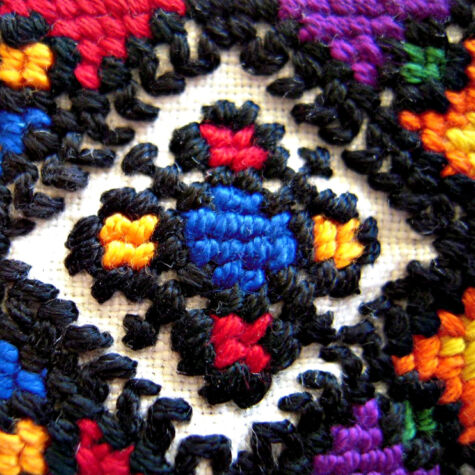
Collar close-up
This is a close-up of a collar of a man’s shirt from late 19th / early 20th century Rusky Banyliv village, Bukovyna province (Ukraine). In traditional Ukrainian symbolism, the rhombus represents fertility, birth and seeding. It is associated with the harrow, which prepares the soil for seeding. Many harrows are comprised of a plethora of rhombuses in their structure. Fittingly, this motif has several diamonds or rhombs within it.
-
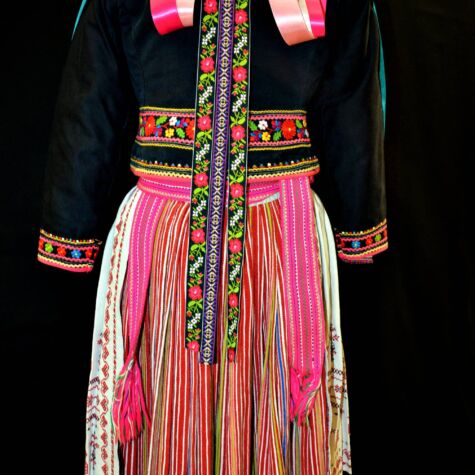
Yavoriv outfit
This back of the Yavoriv district (Lviv oblast) outfit features a black kabat with floral satin stitch, stem stitch, yellow chain stitch and some pink ric-rac; a pink kraika (woven belt), and a vertically striped linen-cotton skirt called a spidnytsia-shorts.
-
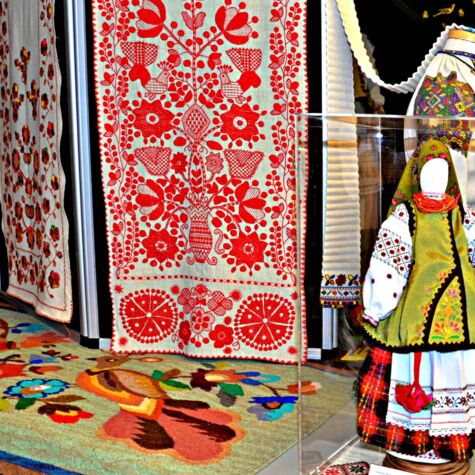
Mixed Table Display
This table display features:1) a motanka representing Kyiv oblast by Yuriy Melnychuk; 2) a costume from Verkhovyna district, Ivano-Frankivsk oblast, Hutsul region, that has a linen sorochka and linen peremitka with multicolored embroidery (namely satin stitch), woven belt (kraika) and 2-piece skirt (zapaska); 3) a wedding kylym from Poltava with two birds; 4) two embroidered ceremonial towels (rushnyky) featuring tree of life motifs, one of which is a wedding rushnyk with birds; 5) the back-left side of a Sniatyn district, Ivano-Frankivsk oblast, Pokuttia region bouse and sheepskin vest (kyptar) are at the far left on the table; 6) a child in full Yavoriv district (Lviv oblast) costume is in the far right background.
-
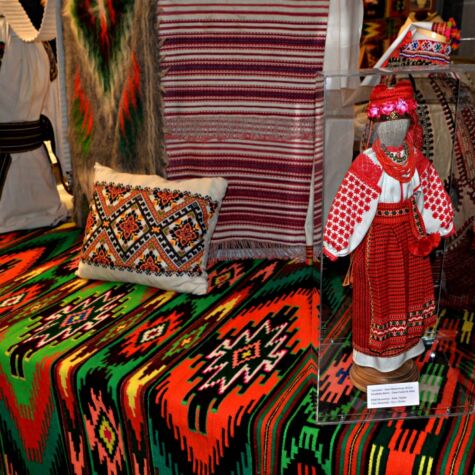
Hutsul kylym
This table display features a Yuriy Melnychuk motanka from Horodenka district, Ivano-Frankivsk oblast, Pokuttia region in a wedding headdress; a tapestry (kylym) on the table from the Hutsul region; a cross stitched cushion (podushka); a long narrow tablecloth (skatert) from Nazirna village, Kolomyia district, Ivano-Frankivsk oblast; and a small wooly bed cover (lizhnyk) from the Hutsul region with green and orange highlights.
-
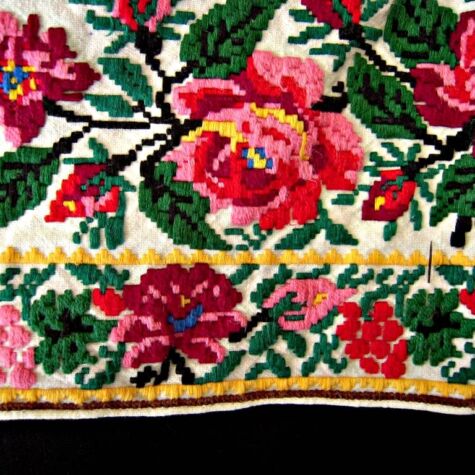
Chemise cuff
This cuff of a woman’s dodilna sorochka (full-length chemise) from Bukovyna features satin stitch.
-
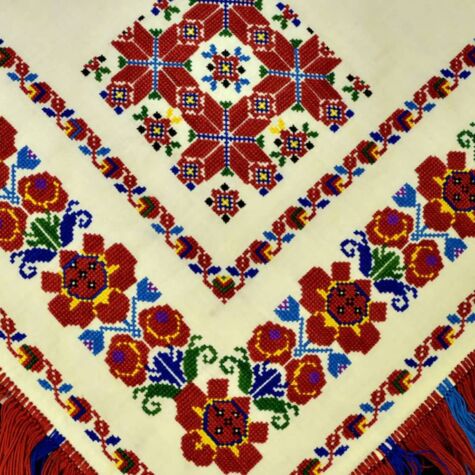
Head Scarf
The khustka from Yavoriv district, Lviv oblast is cross stitched in a traditional design from the first half of the 20th century.


